#txepiva
Text
Meet our scientists!
ESRA (European Space Research Agency) has officially launched the second phase of its Many Hands project.
With the motto "Manus multae, mens unum" (many hands, one mind), this scientific endeavour seeks to create and maintain small, mobile teams of recombinant scientists in the field on Pandora, in constant communication with their original donor back on Earth.
ESRA thrives to better understand the encironment of Pandora and continue the interrupted research of its many Na'vi cultures and societies.
The RDA recombinant technology allows for scientists to imprint their mind and knowledge onto multiple copies of avatars, who are awakened and brought up to date on recent discoveries while in orbit. They are then sent down to Pandora with their own individual equipment and research goals. Those are solo missions. Each avatar aims to join a local clan or tribe, for the sake of their research and survival. There are no planet-side ESRA facilities, so our researchers depend on RDA air drops for any support, like tech replacement. Communications are maintained via several relays, and discoveries regularly reported to the original human researcher, who then compiles and publishes the finished papers. They work in collaboration with our entire recombinant team to ensure the relevant exchange of knowledge and set new goals.

Eyris Makri is a an exoanthropologist with ESRA. She is part of a 5 bodied recombinant system spliced from Txepìva DNA. Her human self works in collaboration with four recombinants who underwent specialty training during the months of deceleration and approach to Pandora.
Eyris Prime (above), the lead of the mission, specialises on Na'vi communication and published 'Advanced use of volcanic plains stunbat across clans' (2168), 'History and welfare of the working stunbats of the Tau'un clan' (2170) and 'Mythological impact of the domestication and breeding of the viperhounds' (2172).
Every recombinant is deployed with a failsafe (either a neural guillotine or a heart patch), to help ensure there is no repeat of the J. Sully situation. All of our scientists sign up willingly and are sponsored throughout the shipment years. They retain ownership of their DNA and personality inprint after the creation of their recombinants.
See : research on Viperhounds
Research on Stunbats
Both conducted with Serafiina Hukkala (@straydaddy)
#avatar#atwow#avatar 2#jc avatar#avatar fan lore#fanart#concept art#na'vi#na'vi oc#pandora#stunbat#viperhound#txepiva#recombinant#recom#avatar recom#recom oc
22 notes
·
View notes
Text
Stunbat Lore!
@bluedaddysgirl and I have been designing these creatures that accompany their Txepìva na'vi.
Here is our earlier thread on 'viperhounds', domesticated and extremely diverse 'dogs' of these volcanic plains dwelling clans!
...And here is @bluedaddysgirl's original thread on our second creature, the Stunbat!
I happened to make new edits and whole illustrations when I was re-formatting the contents of the original Stunbat posts for Twitter/X, so here's an updated version of the Stunbat thread!



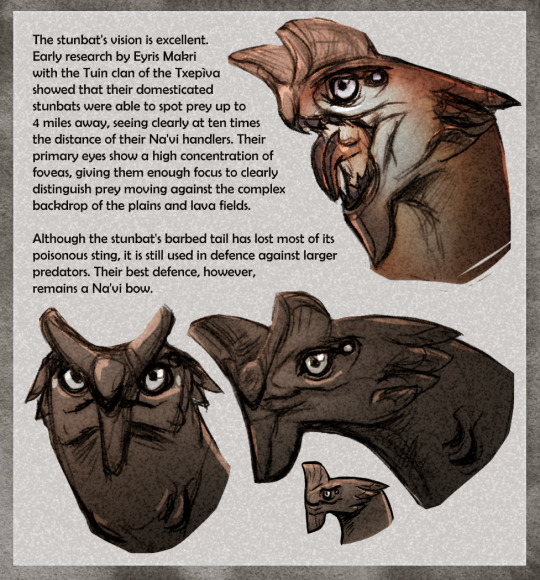


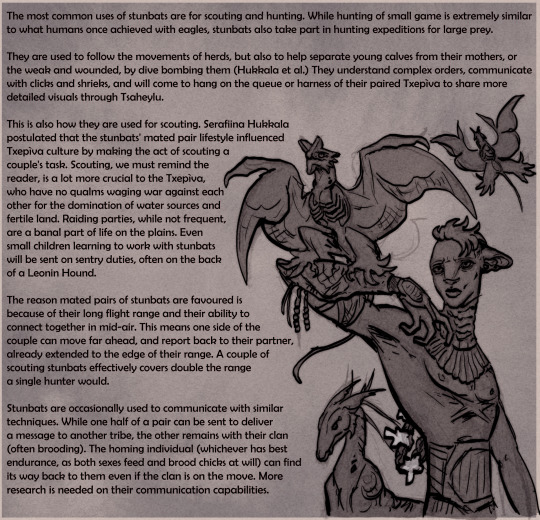

Link to the Twitter thread;
https://x.com/knarme/status/1773035137699135920?s=20
Credits;
The Txepìva na'vi, their volcanic plains biome, the illustrations on the 'last page' & and all the text is by @bluedaddysgirl
The basket illustrations and Stunbat lore are collaborations between myself @straydaddy and @bluedaddysgirl.
The designs of the Stunbats and Viperhounds and the rest of the illustrations are by me, @straydaddy
#avatar#avatar 2009#james cameron's avatar#avatar the way of water#avatar twow#atwow#avatar 2022#avatar fanlore#avatar fanart#avatar fanfiction#avatar fandom#avatar fanclan#na'vi#na'vi oc#na'vi clan#na'vi fanclan#viperwolf#nantang#riti#stingbat#creature design#xenobiology#speculative biology#speculative evolution#Txepìva#viperhound#stunbat
42 notes
·
View notes
Note
I saw your post about the Na'vi who live near volcanoes! (I loved it so much!) What examples do you have of their clothing? And what rites of passage do they have since making a bond with animals isn't a normal occurrence?
Anon, thank you so much!! I have the day off so I spent the afternoon doodling ideas for the Txepiva, half of them not even what you asked for lol
Here's the full sheet, which you can see in full size by opening in a new page.
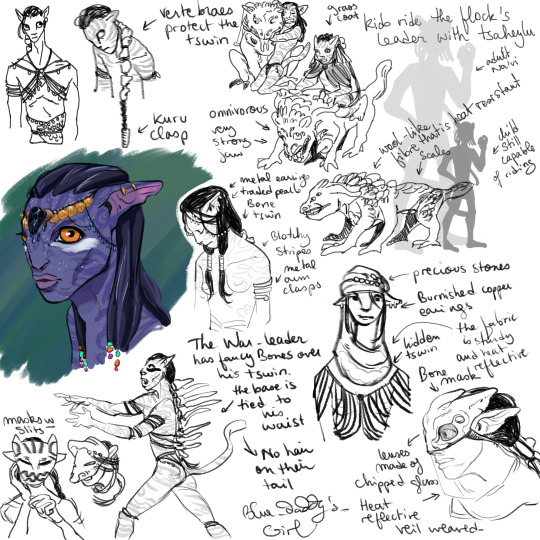
Clothes :
Let's say they are mostly pastoralist nomads. They have an animal, an omnivorous creature that lives in small flocks of 20-30 members. They have a scaly/platted back and tail, but also tufts of heat resistant fibers close to a wool, just not nearly as compact. It's designed to keep them cool around the neck and chest.
Txepiva task young children with herding the flocks, making tsaheylu and often riding the flock's leading animal, leading them all by directing the one. They are used for meat, but also for their fibers, which are made into protective veils, as heat reflective as anything Na'vi can produce.

This made me think about masks (made of bone or worked leather) that would use glass lenses and veils made of that material to get extra close to lava. A Pandoran take on the protective suits we wear on earth.
I have had to honour of getting very close to a lava flow, and my experience is that when you're 20m away from it, it feels as hot and oppressive as when you're 1m away from a raging bonfire. If they need to get close, extra protection would help.
Masks could also have simple slits, though idk how much protection that would offer.
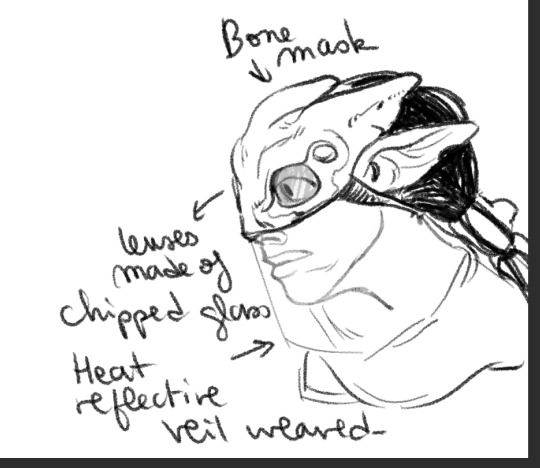

And since they can weave heat resistant fabric, but not everyone would get close to lava, you could also have more casual but still protective gear, mimicking Tuareg and other desert dwelling headgears and scarves. You could wrap the queue (tswin) inside of it and have it hidden from view. My adult Txepiva who aren't young herders or hunters have little use of their tswin outside of mating.

They would have access to a lot of precious stones. A lot of jewelry would be crafted there and be part of their main exports to other clans, alongside glass objects. Vials and glass rings would be particularly popular, as well as beads.
They'd import a lot of dyes and dried plant material in exchange. The one thing that is taboo for other clans though is metal.
That doesn't stop the Txepiva from using it for themselves, in earrings, worked plates, kuru clasps, brooches, etc. Copper is particularly easy to obtain around volcanic faults.
The other stone of choice is obsidian. I tried to give her white paint under her eyes instead of the black one I did on my original design.
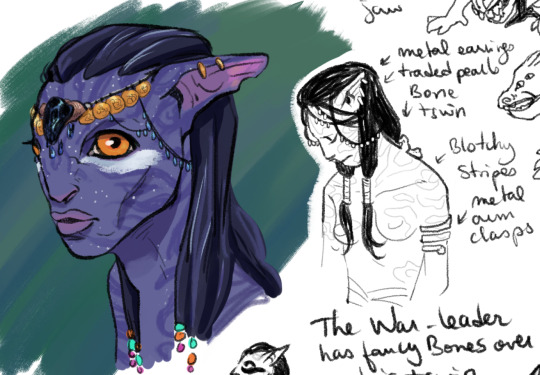
But at the end of the day one of the most used materials in the clan is Bone. All warriors and scouts wear chains of vertebrae over their tswin. It's to prevent being easily killed by the queue being grasped and severed at the base.
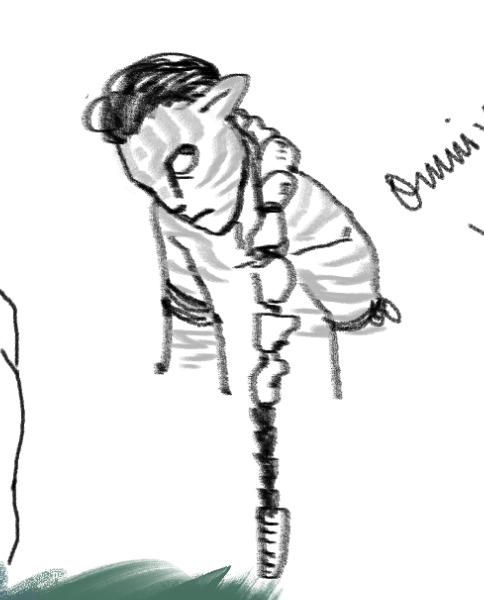

The war chief, leader who takes charge of the clan whenever they face conflict or are readying an assault on another clan, tends to wear more flashy gear. This one collected vertebraes with a long neural spine :

The tswin and its bones are tied to his waist so they don't sway or get in his way. It's mostly ceremonial gear, I don't think he'd bedeck himself like this for war.
Didn't draw any shoes, but the Txepiva are occasional users of the stuff, especially on active volcanic plains.
Rites of Passage :
Not everyone is a warrior, so I assume they'd have different rites for different people.
Those who are warriors might be tasked to prepare their own kit to go on a quest of some sort. A raid to steal an animal, or to go deep into active lava flows to collect precious materials and prove themselves.
Or they might be cast out altogether for a whole year or more, young people forming roving bands from different clans who have to get along and conjoin their skills to survive. That feels a little extreme, though I've explored the idea of the ash people having a yearly meeting where most clans peacefully get together and trade, party, bang, and mate across clans to, you know, clean up that gene pool.
It being the moment roving bands return and have a ceremony accepting them as adults and able to join a mate and a new clan would be great. Another group of youth could be cast out at the end of that meeting, only to return in a year.
That has the advantage that it could include people whose main skill isn't hunting or killing, as they'd be just as valuable for a band's survival.
But otherwise I enjoy the idea of yuong people building a 'dowry' for themselves. It's not about mating at all, but to showcase their skills for the great meeting. Elders of all clans gather and inspect the ivory carvings, dyed weaved scarves, worked stones and jewels, or even the smithed blades and copper beads produced by this youth who claims to be an adult. They might prepare a single enormous project, or present a collection of wares.
If approved, then they would receive presents prepared for them by their friends and family ahead of time in a ceremony welcoming them as adults, and they'd be allowed to go trade all their hard work.
And that gathering place definitely has a fun-time tent for adults but also a massive complex of hot springs. It's a sacred place with a lot of growing soul trees where killing or fighting is completely forbidden.
You have to leave your clan's baggage at the metaphorical door.
They'd also have sport competitions and friendly matches, as well as conflict resolution.
OK going to shut up now because I think I could go on a little too long!!
#Thanks anon#anon ask#avatar meta#avatar lore#(the made up kind)#ash clan#txepiva#avatar#atwow#avatar 3#fire na'vi#ash na'vi#nomadism#fanart#avatar fanart#na'vi oc#avatar oc#my art#headcanons
179 notes
·
View notes
Text
Let me tell you a story about Mansk
Well, more like a story about me, lmao. Please look forward to a fantastic post on creature design for the Txepiva clan I made up and have been posting about. Soon!
@straydaddy has been making my little creatures come alive, and I can't wait for you to see them, they look pulled out of a book on Pandoran wildlife.
Anyway, as we were doing some back and forth about them, how they evolved, how the clans use them, etc. Straydaddy kept making jabs about Mansk grilling on lava. And I figured that yes, it'd be great for him actually. He could evolve from grillmaster Mansk to firemaster Mansk. IDK.
Then I remembered I have two pieces of art in the same development stage...
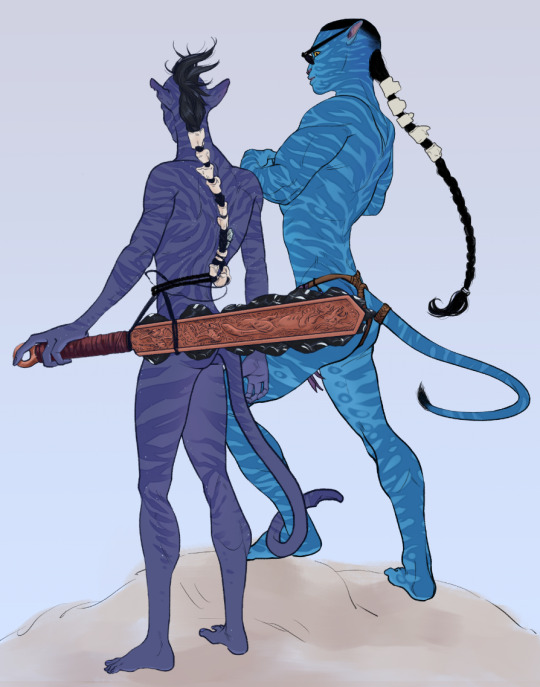
So yes, I guess the Txepiva have a year long period where a youth proves themselves by exploring the world, and this one could well have gone to the sea side, and plucked Mansk out of a pile of seaweed.



But then, you know what, I think I still favour Sex Positive Ace Mansk, and I feel like he'd be happier in a trouple.
And you know who go to the Ash clans? Outcasts. So how about this Txepiva warrior gets himself a huge, scared, ice clan outcast wife?
She's got a head on them minimum. Big woman and her two malewives.
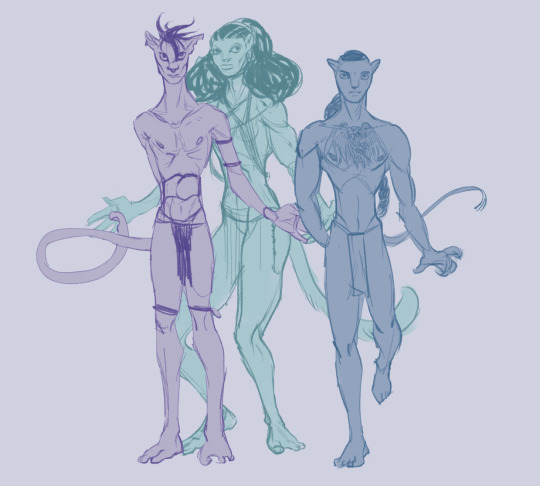

Mansk is the shortest, yes.
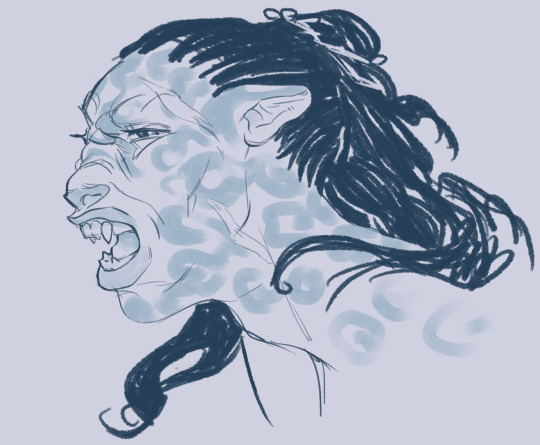
You do NOT fuck with her husbands.
#ash clan#ash people#ice clan#txepiva#mansk#recom mansk#avatar#character design#ash clan mansk#na'vi oc#my art#sketches#atwow#fanart#avatar 2
114 notes
·
View notes
Text
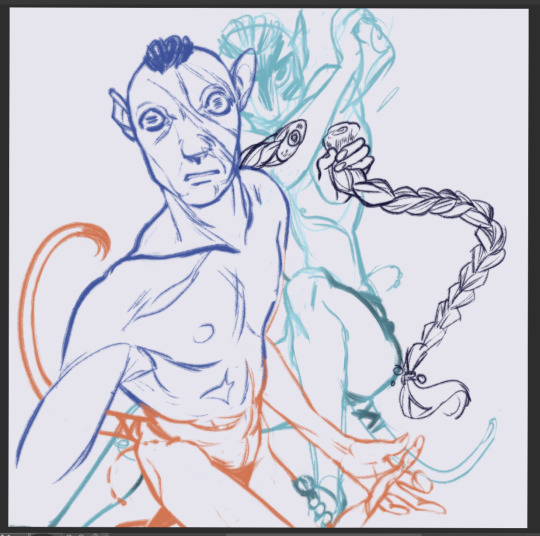
current sketch : txepiva warrior killing an omatikaya hunter in a single strike.
11 notes
·
View notes
Text

Selective breeding of viperhounds by the Txepiva clans
The Txepiva clans, also known in some parts as the Ash People, have no ikran and no pa'li. They are long distance runners and hunters, often on the move. Many of them are nomadic pastoralists, a practice unknown among the rest of the known Na'vi.
Their habitat, in turn bleak and burnt or rich and green, rarely forms anything close to a forest. The clans are always on the move, frequently fighting over territory, and yet regularly meeting with others in great gatherings. The largest, meant to reunite all the disparate Txepiva clans, is called the Tsawlultxa, and is the perfect opportunity to discover and study the stunning variety of Nìsayntang.
Just like mankind adopted wolves and turned them into dogs, the Txepiva adopted the plains' viperwolves. Millenia of selective breeding created the Nìsayntang, which the RDA catalogues as viperhounds.
Most neighbouring clans outside the Txepiva look down on breeding, preferring to go in the wild to capture their own mounts. We're left to understand it verges on taboo. As usual, the Txepiva seem to hardly care or take notice of their neighbours' distaste.
The relative isolation of each clan has allowed for the development of several subtypes of Nìsayntang.
Some clans have hounds whose forward arms have evolved to grab prey, while in others it's the secondary pair, with the elongated fingers of the hand coming back to fold over the rib cage in a position reminiscent of the stunbat's secondary arms.
Another clan breeds specifically for hunting in low light visibility.
Here are some examples of breeds of Nìsayntang!
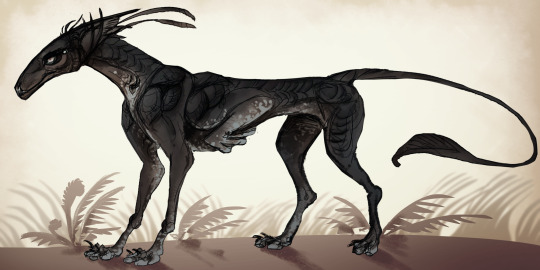
The most standard breed type, seen all across the plateaus and plains. They reach up to a Na'vi's knees or higher, much like a greyhound for humans. They're excellent runners and hunt as a pack, keenly aware of the Na'vi hunters movements. They can carry and manipulate objects with the prehensile limbs that have retracted against their chests. It's most commonly the middle pair of limbs, but as we'll soon see, some clans have bred hounds whose frontal limbs are the ones that evolved to hold and grab.
Nìsayntang are intelligent creatures, keen to help, and capable of understanding complex orders, especially through tsaheylu. This agile breed, quick on its feet, is favoured by the clans that raise srä‘etnaw (the livestock at the source of aforementioned pastoralism).
They'll assist their Na'vi with crafts, carrying things across the camp, leading scouting missions and reporting what they see, or for the best trained one, even hold the meat before it gets grilled! They also use their hands to grab stray srä‘etnaw pups and bring them back into the fold.
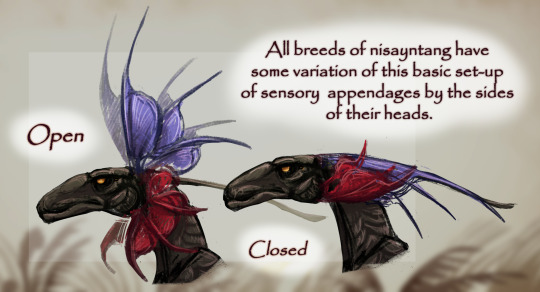
The facial appendages of Nìsayntang are flexible sensory organs. They help them sense their environment, but also play a major role in how they communicate between pack members. Think of the way wolves communicate with their ears, back on Earth.
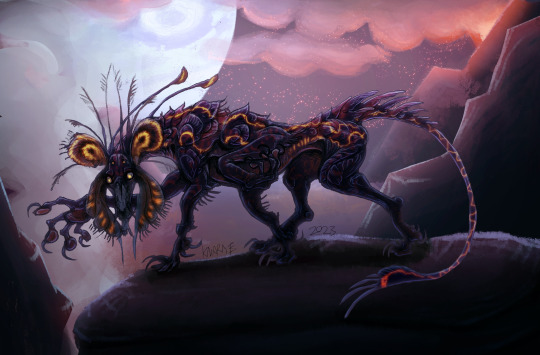
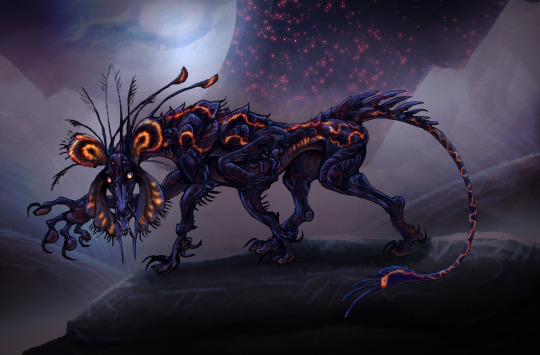
This variation is quite rare, and bred by a single tribe that favours night-time hunting and lives along black volcanic cliffs and lava fields. It's one of the darkest environments known in Pandora, especially during eclipse.
Their Nìsayntang have greater control of their natural bioluminescence, granting them better camouflage. Like a cuttlefish fooling its prey, they can modulate and increase the bioluminosity, creating alluring displays. The sensory strangeness causes their prey to freeze, equally curious and confused, and now vulnerable to ambush.
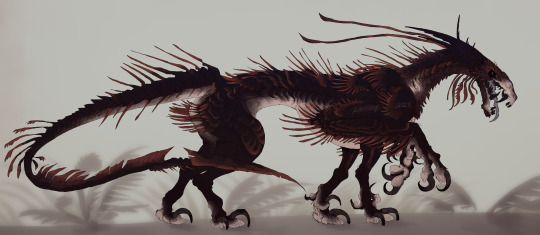
The stem-nisayntang were quite the genetically diverse and chaotic bunch, and the Na'vi of the Ash clans have been practising selective breeding on them for far longer than humans have with dogs.
This is an example of the aforementioned breeds in which it's the foremost limbs that have developed to extend and grab. It's the largest of the breeds presented in this study, as large to a Na'vi as a lion to humans, and aptly nicknamed "Leonin Hound" by first contact researchers. Their huge, heavy arms make them ambush predators, preferring bursts of speed and action to their cousins' long distance running. Their hands aren't as nimble or crafty, each fingers closer to sharp, robust talons.
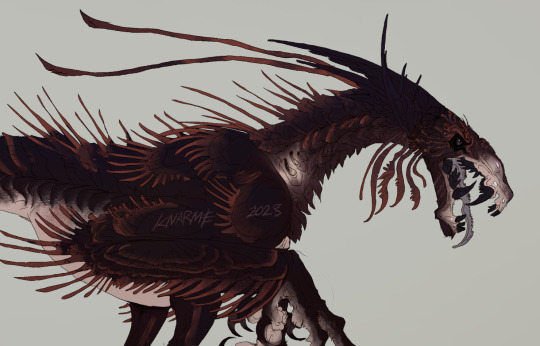
They have serrated teeth that tear through muscle and cartilage with unsettling ease. Their bite can even cut through most of the natural keratinous armour of Pandoran animals.
Their bodies are covered in bristles that help them sense vibrations in the air and ground. Those keen senses and efficient ambush tactics have gained them a reputation as “All-knowing guard hounds” among travellers who’ve met their keepers.
Despite the fearsome appearance and size, their pack mentality, as well as their ability to bond with their entire clan, make them desirable playmates for children, and it's not rare to see a couple of Txepiva youngsters tasked to guard toddlers and younger children, doing so with the help of their hounds. It's also quite common for them to ride on their back. Despite what a human might think of such a sight, it's as safe and natural to the Txepiva as riding an ilu as a child is for the Metkayina.
Bred to fend off the fearsome wildlife of the plains, the Leonin hounds are fiercely efficient at it and seem to have had their sense of fear bred right out of them. As such, they're one of the most widespread breeds in the plains. A handful of clans produce pups, and some are then traded at the great yearly Txepiva gathering. A clan might have their own specialised breed that has been living alongside them for untold generations, and still keep a couple of the Leonin hounds to help safeguard their camps.
Part I of @straydaddy (art and design) and @bluedaddysgirl (lore concept) in-world collaborative study, "Introduction to the Txepiva clans, their nomadic pastoralism and niche selective breeding practices in species of stingbats and viperwolves".
On twitter we are Knarme and Bluedaddysgirl
#avatar#atwow#avatar 2#jc avatar#avatar fan lore#fanart#viperwolf#space doggos#aliens#alien biology#xenobiology#xenozoology#speculative evolution#creature design#concept art#creature art#creature concept#alien concept#fan art#collaboration#alien design#alien creature#spec evo#spec bio#speculative zoology#speculative biology#na'vi#na'vi oc#nisayntang#pandora
157 notes
·
View notes
Text

Avatar-sona for the Ash clan lore posts @straydaddy and I are doing... We may as well be in world. So meet the xenoethnologist who first met the Txepiva clans! And now waiting for their xenobiologist colleague who was on that same expedition :3
Here's the photo this is based on, for the curious!
91 notes
·
View notes